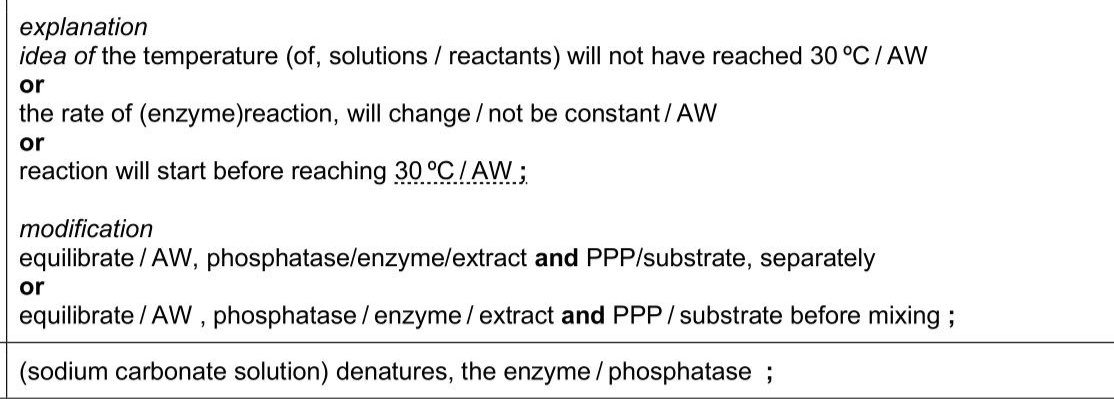Phosphatases are enzymes that catalyse the removal of phosphate from other molecules, releasing inorganic phosphate ( $$\(\mathrm{P}_{\mathrm{i}}\)$$ ). A phosphatase can be extracted from mung bean seedlings, Vigna radiata. A student found a published method to extract phosphatase from mung bean seedlings. - Use a pestle and mortar to grind mung bean seedlings, with a small volume of distilled water, to make a paste. - Add distilled water to the paste to make a mixture with a total volume of $$\(50 \mathrm{~cm}^{3}\)$$. - Filter the mixture and put the filtrate into a clean centrifuge tube. - Centrifuge the filtrate until a solid pellet is formed, as shown in Fig. 1.2. - Pour the liquid extract containing phosphatase into a clean test-tube. The student read that the optimum pH for phosphatase extracted from mung bean seedlings is less than pH 7.0 . The student decided to investigate phosphatase activity, using the substrate phenolphthalein phosphate (PPP). In the first four steps of the method, the student: - mixed $$\(5 \mathrm{~cm}^{3}\)$$ of pH 6.0 buffer solution with $$\(1 \mathrm{~cm}^{3}\)$$ of a $$\(1.0 \%\)$$ solution of PPP in a test-tube - added $$\(1 \mathrm{~cm}^{3}\)$$ of the phosphatase extract to the test-tube and started a timer - incubated the test-tube for 10 minutes in a water-bath at $$\(30^{\circ} \mathrm{C}\)$$ - stopped the enzyme reaction after 10 minutes, by adding $$\(5 \mathrm{~cm}^{3}\)$$ of $$\(10.0 \%\)$$ solution of sodium carbonate. Sodium carbonate solution is alkaline. (i) The buffered PPP solution and the phosphatase extract were mixed and then placed in the water-bath. The student identified this as a source of error in the method. Explain why this is a source of error and state how you would modify the method to remove this source of error. explanation . . . . modification . . . . (ii) Suggest how the addition of $$\(10.0 \%\)$$ solution of sodium carbonate stops the enzyme reaction. .
Exam No:9700_s25_qp_52 Year:2025 Question No:1(b)
Answer:

Knowledge points:
3.1.1 state that enzymes are globular proteins that catalyse reactions inside cells (intracellular enzymes) or are secreted to catalyse reactions outside cells (extracellular enzymes)
3.1.2 explain the mode of action of enzymes in terms of an active site, enzyme–substrate complex, lowering of activation energy and enzyme specificity, including the lock-and-key hypothesis and the induced-fit hypothesis
3.1.3 investigate the progress of enzyme-catalysed reactions by measuring rates of formation of products using catalase and rates of disappearance of substrate using amylase
3.1.4 outline the use of a colorimeter for measuring the progress of enzyme-catalysed reactions that involve colour changes
3.2.1.1 temperature
3.2.1.2 pH (using buffer solutions)
3.2.1.3 enzyme concentration
3.2.1.4 substrate concentration
3.2.1.5 inhibitor concentration
3.2.2 explain that the maximum rate of reaction (Vmax) is used to derive the Michaelis-Menten constant (Km) which is used to compare the affinity of different enzymes for their substrates
3.2.3 explain the effects of inhibitors, both competitive and non- competitive, on the rate of enzyme activity
3.2.4 investigate the difference in activity between an enzyme immobilised in alginate and the same enzyme free in solution, and state the advantages of using immobilised enzymes
Solution:
Download APP for more features
1. Tons of answers.
2. Smarter Al tools enhance your learning journey.
IOS
Download
Download
Android
Download
Download
Google Play
Download
Download
